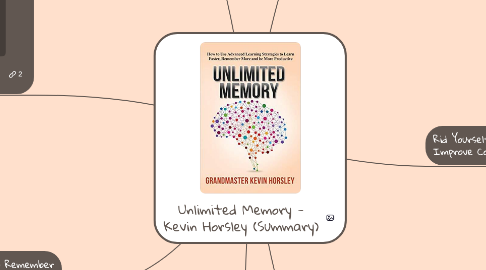
1. Instantly recalling understanding: Kevin Horsley at TEDxPretoria
2. Sort Information into Categories that Already Exist in Your Long-Term Memory
2.1. Use the loci method
2.1.1. Also known as the route method
2.1.2. Combine new information with something already familiar
2.1.2.1. Put items you want to remember at specific locations along a route that is already vivid and familiar in your mind
2.1.2.2. e.g. your way to work, your own body, or a walk through your house
3. Use Sounds to Remember Numbers and Dates
3.1. Transform numbers into images that will stick in your mind
3.2. First, change numbers into letters / change how those letters sound
3.3. Example
3.3.1. Number zero
3.3.1.1. Can be represented by the letters s, z and c
3.3.1.2. Think about a hissing wheel
3.3.1.2.1. 0 looks like a wheel anyway!
3.4. Each number from 0-9 can be assigned a group of similar sounding consonants
3.4.1. You can also use the shape of the numbers to assign sounds
3.4.1.1. e.g. flipping a 3 makes it look like an m
3.5. Now, if you're trying to remember a date, write down the letters that represent them and try to make up a word
3.5.1. e.g. 1969
3.5.1.1. No need to remember the first 1 because most important dates we want to remember happened in the last millennia
3.5.2. 969
3.5.2.1. b, sh, p
3.5.2.1.1. BiSHoP
4. Use the Four C System to Remember Names
4.1. C
4.1.1. Concentrate
4.1.1.1. Say the name out loud and repeat it
4.2. C
4.2.1. Create
4.2.1.1. To make it stick, take the name apart and use any words that come to mind to create a memorable image
4.3. C
4.3.1. Connect
4.3.1.1. Connect the image with the person's face (think of their most striking feature!)
4.4. C
4.4.1. Continuous use
4.4.1.1. Revisit the names, maybe add them to your diary and review them often!
5. About the Book
5.1. Title
5.1.1. Unlimited Memory
5.1.2. How to Use Advanced Learning Strategies to Learn Faster, Remember More and be More Productive
5.2. Published
5.2.1. TCKPublishing.com
5.2.2. 2016
5.3. Author
5.3.1. Kevin Horsley
5.3.1.1. International Grandmaster of Memory
5.3.1.2. World Memory Championship medalist
5.3.1.3. Two-time World Record holder for The Everest of memory tests
5.4. Get it on Amazon
6. Rid Yourself of Conflict to Improve Concentration
6.1. Anything that leads your mind in different directions and stops you from concentrating is bad
6.2. Stop multitasking
6.2.1. It slows you down by 50%
6.2.2. It increases your chances of making a mistake by 50%
6.3. Prevent your mind from wondering by giving yourself a purpose
6.3.1. Remind yourself why you wanted to concentrate in the first place
6.4. Use the PIC rule
6.4.1. P
6.4.1.1. Purpose
6.4.1.1.1. Gives you a reason for learning
6.4.2. I
6.4.2.1. Interested
6.4.2.1.1. Ask yourself questions so you become interested
6.4.3. C
6.4.3.1. Curious
6.4.3.1.1. Ask yourself questions so you become curious
7. Use Your Creativity to Bring Information to Life
7.1. Use your creativity to make a memorable movie or picture
7.2. When memorizing foreign words
7.2.1. Break them down into smaller words which sound similar to others
7.2.2. Make them sound funny or absurd
7.2.3. This way they become more memorable
7.3. Use the SEE method
7.3.1. S
7.3.1.1. Senses
7.3.1.1.1. Create a multi-sensory image
7.3.1.1.2. This is far easier to remember than simple text
7.3.2. E
7.3.2.1. Exaggeration
7.3.2.1.1. Create funny, fantastical images
7.3.3. E
7.3.3.1. Energize
7.3.3.1.1. Add a bit of action to make the image more vivid
